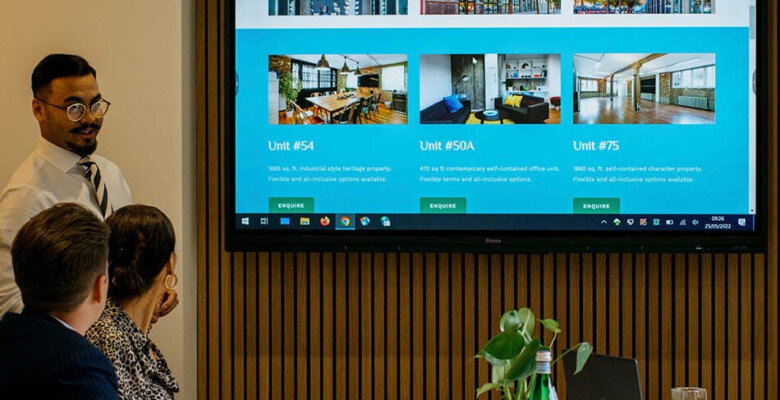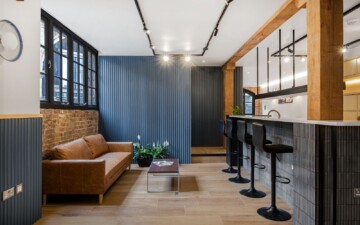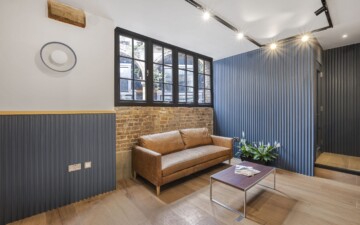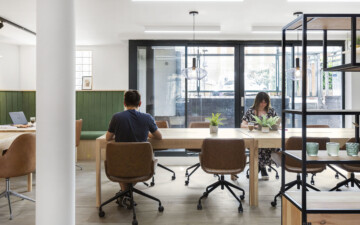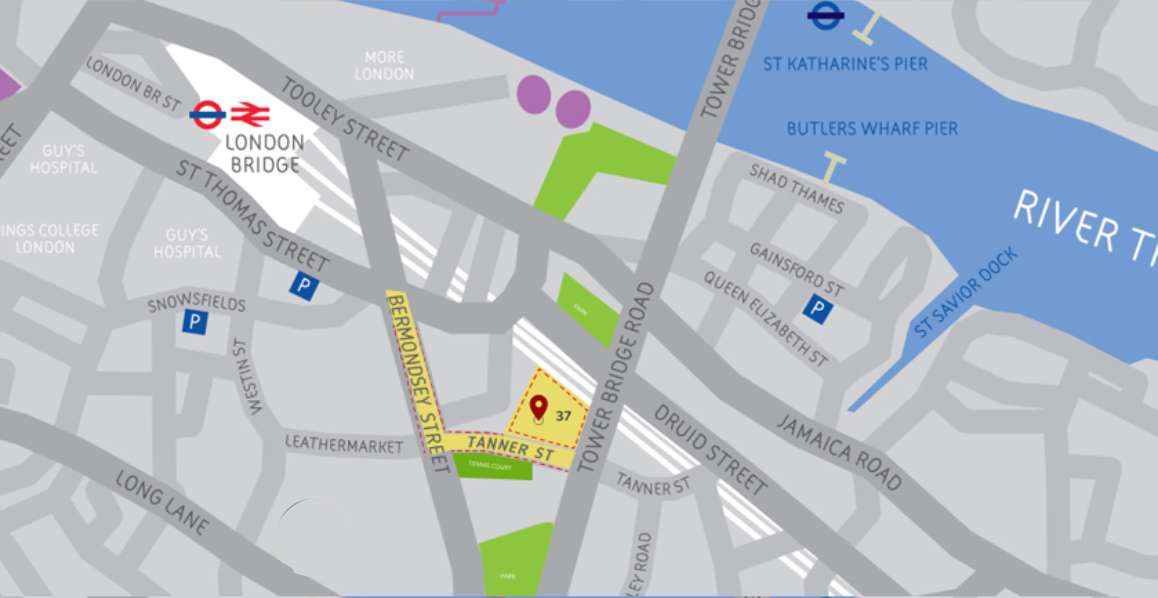The Oxford Dictionary defines agility as the ability to move quickly and easily. In workplace parlance, this translates to adapting to the changing environment. Globalisation and technological advancements have changed the old traditional business models and work methodologies the world over. Embracing agile workplace designs has become the preferred approach for creating an atmosphere that not only boosts productivity but also ensures companies stay competitive by moving away from traditional business models and work methodologies in favour of more agile methodologies.
According to a study conducted by McKinsey & Company, organisations that integrate agile methodologies in their operations experience a remarkable 60% improvement in employee engagement, customer satisfaction, and operational performance. Additionally, insights from the Agile Project Management Report highlight that a substantial 71% of companies worldwide are now embracing these agile approaches. This widespread adoption is a universal acknowledgment of the advantages that agile methodologies bring to the table, such as enhanced productivity, increased innovation, and greater employee satisfaction.
At its core, an agile approach demands flexibility, adaptability, and responsiveness from companies. It empowers employees to take ownership of their work and make informed decisions. Central to this approach is the agile work environment, providing the essential framework and resources for employees to tailor their work styles to best meet their needs.
What is an Agile Workplace?
An agile workspace prioritises flexibility and adaptability to meet the changing needs of the organisation and its employees. This type of work environment encompasses both physical and operational aspects. In terms of physical design, agile workplaces offer various spaces that facilitate employee productivity. Moreover, agility also pertains to the approach taken towards work. Work agility involves choosing the optimal time and place for work. An agile workplace facilitates this flexibility, fosters collaboration, boost creativity, and enhances employee satisfaction.
“The fundamental unit of work in an agile transformation is ‘Creating the Environment’ for agile to be able to operate” – Mike Cottmeyer
What are the Qualities of an Agile Work Environment?
- Accessible: An agile work environment should have minimal barriers, such as doors and walls, to ensure easy movement in and out of spaces. Prioritising ease of movement is crucial since people don’t do well in small, confined areas.
- Adaptable: It is important to consider the daily requirements of employees when creating a workplace, such as easy rearrangement of furniture, ample electrical outlets, and provisions for desks. The workspace should be designed to allow for quick adaptation by making minor adjustments as and when required.
- Comfort: An important factor that can increase employee productivity is their comfort level in the workplace. When employees feel uncomfortable, they tend to spend more time and effort adjusting to the environment rather than focusing on their work.
- Peace: Creating a calm atmosphere in a dynamic workplace can be challenging. Nonetheless, it is vital for boosting employee productivity and is a key part of an agile workplace culture. This may involve ensuring each employee has a bit more privacy.
What is the Difference Between Agile Methodology and Agile Environment?
|
Agile Methodology |
Agile Environment |
| Definition |
Agile Methodology is a project management approach emphasising iterative development and collaboration. |
An agile environment is a workplace designed to support agile principles, promoting flexibility and collaboration. |
| Focus |
It processes and frameworks (e.g., Scrum, Kanban). |
Physical workspace and cultural aspects. |
| Key Practices |
Sprint planning, daily stand-ups, iterative progress, continuous feedback.> |
Open floor plans, flexible workstations, collaboration zones, and technology-supporting teamwork. |
| Objective |
to enhance project delivery, flexibility, and customer satisfaction through adaptive planning. |
to enable agile practices, foster innovation, and enhance team collaboration and productivity. |
What are the Different Types of Agile Workspaces?
In the dynamic environment of agile workplaces, fixed desk assignments are rare, with employees often grouped in specific workstation clusters depending upon their team needs. This flexibility encourages individuals to select the environment that best aligns with their current task. Here are some types of agile workspaces:
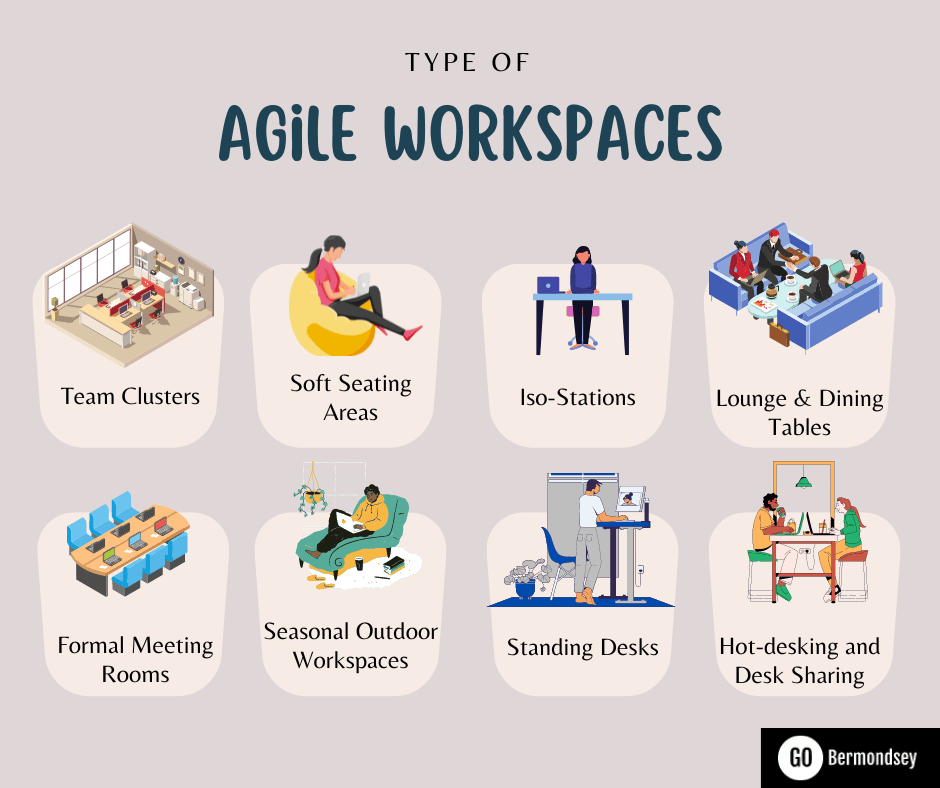
- Team Clusters: Employees often do not have fixed desks, with teams grouping in designated workstation clusters as needed.
- Soft Seating Areas: Ideal for informal meetings, collaborative discussions, or relaxation breaks.
- Quiet Zones: Dedicated spaces for deep focus, private study, and tackling complex tasks.
- Iso-Stations: Quick-access points for transient tasks such as email checks, schedule confirmations, or pre-meeting preparations.
- Lounge & Dining Tables: Support team project work and small group meetings with their versatile setup.
- Formal Meeting Rooms: Designed for more structured, formal meetings, available in various sizes to accommodate different group requirements.
- Seasonal Outdoor Workspaces: Offer both covered and uncovered options to adapt to different weather conditions, providing a much-needed change of scenery for work.
- Standing Desks: Available for those who prefer to work while standing, supporting health and posture.
- Hot-desking and Desk Sharing: By eliminating assigned seating, hot desks and desk-sharing practices encourage flexibility and interaction among team members, fostering a dynamic and adaptable work environment.
What are the Benefits of an Agile Work Environment?
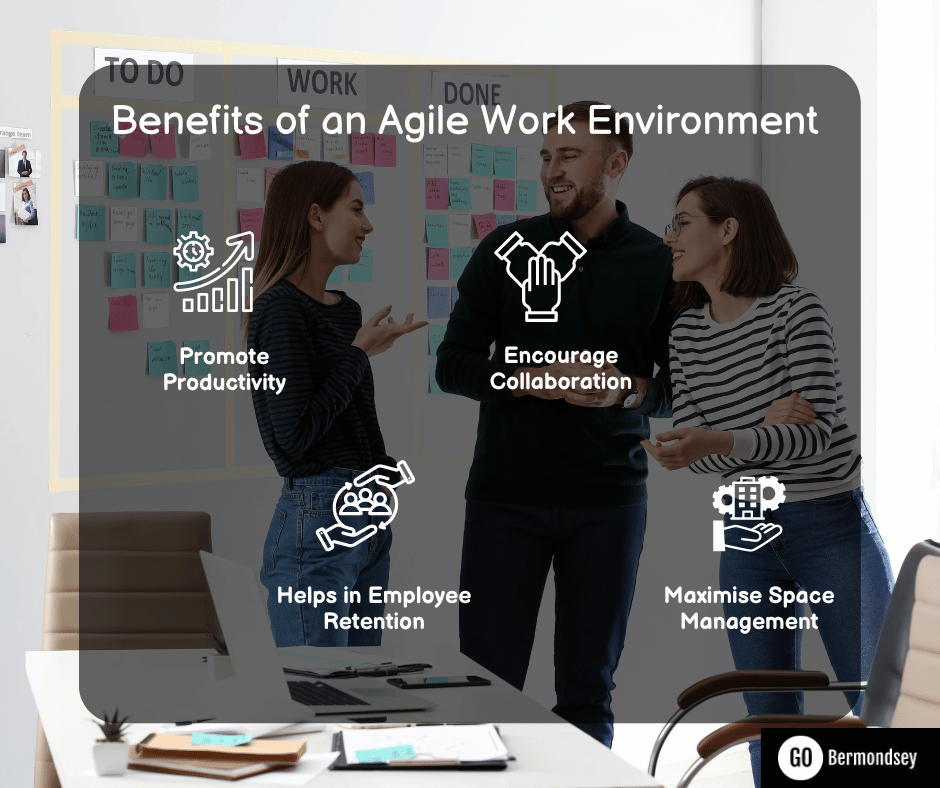
Promote Productivity
Working in a distracting environment can greatly affect an employee’s productivity. However, when people are allowed the freedom to work in a way that suits them best, their productivity and engagement increases. Embracing an agile workspace lets employees work more efficiently.
Encourage Collaboration
Providing employees with the ability and freedom to move around the office space can facilitate greater collaboration. With work no longer restricted to fixed locations like desks or cubicles, employees can easily share ideas.
Helps in Employee Retention
For many millennia, flexibility is more important than pay when it comes to employment. Introducing an agile work environment can offer this sought-after flexibility to both current and prospective employees, resulting in improved employee retention over the long term.
Maximise Space Management
Implementing an agile work environment allows you to optimise your office layout to better suit your and your employees’ needs. This entails using unused or underutilised areas, and planning how the physical workspace will need to change as various teams and personnel use it.
Also read, How to build a customer-centric culture in your business?
Who does Agile Work Best For?
Agile methodologies work best in fields that demand adaptability, such as sectors like software development and the IT sectors, where a significant 97% of organisations incorporate agile practices. Its advantages span various industries, particularly in dynamic project settings. Agile workspaces are suitable for both small and large enterprises navigating digital transformations, with success hinging on an organisation’s cultural openness to change and its leadership’s dedication to implementing these changes. This approach speeds up product innovation and enhances operational performance, establishing it as a versatile strategy for modern business challenges.
What are the challenges in Agile Workspace conversion?
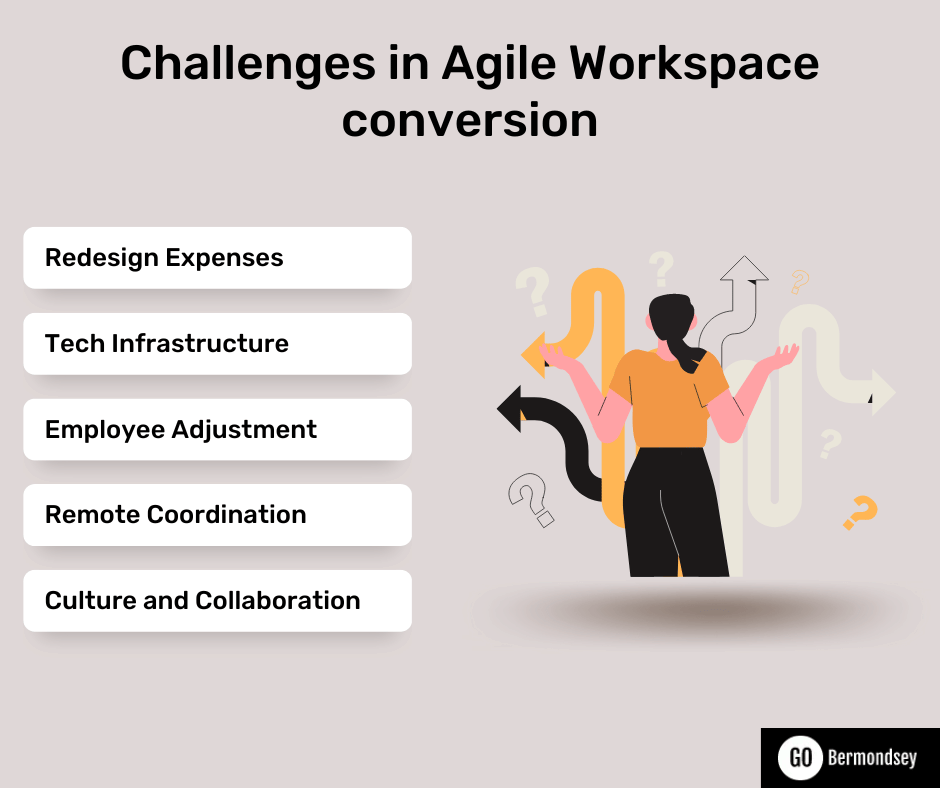
Transforming your workspace into an agile workspace brings its own set of hurdles:
- Redesign Expenses: Shifting to a flexible space layout entails significant costs. You need to maintain a careful balance between agility benefits and renovation expenditures.
- Tech Infrastructure: Establishing a tech-savvy workspace necessitates a hefty investment in digital tools and infrastructure to support varied working styles and remote access, challenging both budget and implementation.
- Employee Adjustment: The transition may meet resistance from staff accustomed to traditional office setups, and they may require targeted support and training to ease into new work habits.
- Remote Coordination: Embracing remote work within agile models demands robust policies and advanced tools to sustain communication and collaboration, presenting a test to management strategies.
- Culture and Collaboration: Creating an agile workspace that enhances, rather than diminishes, company culture and team cohesion involves deliberately fostering interaction, and preserving a cohesive company identity.
What it’s Like Working in an Agile Environment?
Working in an agile environment is dynamic and collaborative. It involves flexible workspaces that adapt to different tasks, fostering teamwork and innovation. Frequent communication and quick decision-making are key, as teams work iteratively on projects.
81% of employees rate peer collaboration apps positively, showing increased satisfaction and productivity in agile environments.
Thus, agile environment enhances productivity, encourages creativity, and allows for rapid response to changes, making work both engaging and efficient.
6 Tips for Creating an Agile Workspace
Here are 6 tips to create a workspace more agile:
- Set clear goals and objectives: Align your workspace design with specific business objectives for maximum impact. Start by understanding the purpose of your agile workspace and identify clearly what you hope to achieve through it. Clear, well-thought-out goals will help you design a workspace that aligns with your business needs and objectives.
- Be flexible and adaptable: Opt for a versatile design to meet changing needs. Agile workplaces, by definition, stand out for their adaptation and flexibility. The workplace design should support multiple working methods and enable simple reconfiguration.
- Fostering collaboration: Provide spaces that enable teamwork and the exchange of ideas. Provide areas where staff members can readily cooperate and work as a team. A collaborative setting can promote increased output and creative solutions.
- Invest in the right tools and technology: Ensure the workspace has the latest technology and resources needed to enable agile work practices, such as cloud-based applications, video conferencing, and collaboration software.
- Foster a culture of continuous improvement: Encourage your employees to provide feedback to enable continuous improvement. Ask staff members to generate ideas for enhancing the workplace, procedures, and practices. A culture of inclusivity produces more innovation and improved results.
- Empower your employees: Trust and empower your team to work independently and efficiently. Agile work culture is characterised by high levels of employee empowerment and autonomy. This in turn leads to improved employee satisfaction and increased productivity. Offer your employees the freedom to work in a way that suits them best.
Why Choose to GO Bermondsey as Your Agile Workplace?
GO Bermondsey is a great option for businesses seeking an agile workplace in London. Its private offices, state-of-the-art facilities, and collaborative environment create a space that encourages innovation, creativity, and productivity. No matter how big or small your business is, GO Bermondsey can provide you with the community, flexibility, and support you need to succeed. So, if you are seeking a dynamic and innovative workspace in the heart of London, GO Bermondsey is the place for you!
